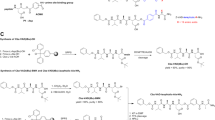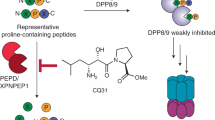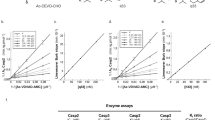Abstract
The caspases are a family of cytosolic proteases with essential roles in inflammation and apoptosis. Drug discovery efforts have focused on developing molecules directed against the active sites of caspases, but this approach has proved challenging and has not yielded any approved therapeutics. Here we describe a new strategy for generating inhibitors of caspase-6, a potential therapeutic target in neurodegenerative disorders, by screening against its zymogen form. Using phage display to discover molecules that bind the zymogen, we report the identification of a peptide that specifically impairs the function of caspase-6 in vitro and in neuronal cells. Remarkably, the peptide binds at a tetramerization interface that is uniquely present in zymogen caspase-6, rather than binding into the active site, and acts via a new allosteric mechanism that promotes caspase tetramerization. Our data illustrate that screening against the zymogen holds promise as an approach for targeting caspases in drug discovery.
This is a preview of subscription content, access via your institution
Access options
Subscribe to this journal
Receive 12 print issues and online access
$259.00 per year
only $21.58 per issue
Buy this article
- Purchase on Springer Link
- Instant access to full article PDF
Prices may be subject to local taxes which are calculated during checkout




Similar content being viewed by others
Accession codes
Change history
21 May 2013
In the version of this article initially published, Irina Krylova was inadvertently acknowledged rather than included in the author list. The author list, author contributions and acknowledgements have been edited to reflect this change. The text and Supplementary Methods have also been updated to more accurately describe phage clone and peptide optimization. The errors have been corrected in the HTML and PDF versions of the article.
References
Alnemri, E.S. et al. Human ICE/CED-3 protease nomenclature. Cell 87, 171 (1996).
Denault, J.B. & Salvesen, G.S. Caspases: keys in the ignition of cell death. Chem. Rev. 102, 4489–4500 (2002).
Riedl, S.J. & Shi, Y. Molecular mechanisms of caspase regulation during apoptosis. Nat. Rev. Mol. Cell Biol. 5, 897–907 (2004).
Talanian, R.V. et al. Substrate specificities of caspase family proteases. J. Biol. Chem. 272, 9677–9682 (1997).
Stennicke, H.R., Renatus, M., Meldal, M. & Salvesen, G.S. Internally quenched fluorescent peptide substrates disclose the subsite preferences of human caspases 1, 3, 6, 7 and 8. Biochem. J. 350, 563–568 (2000).
Stennicke, H.R. & Salvesen, G.S. Caspases—controlling intracellular signals by protease zymogen activation. Biochim. Biophys. Acta 1477, 299–306 (2000).
Shi, Y. Mechanisms of caspase activation and inhibition during apoptosis. Mol. Cell 9, 459–470 (2002).
Salvesen, G. Caspases: cell signaling by proteolysis. in Handbook of Cell Signaling 2nd edn (eds. Bradshaw, R.A. & Dennis, E.A.) 1297–1302 (Elsevier Inc., 2010).
Riedl, S.J. et al. Structural basis for the activation of human procaspase-7. Proc. Natl. Acad. Sci. USA 98, 14790–14795 (2001).
Chai, J. et al. Crystal structure of a procaspase-7 zymogen. Mechanisms of activation and substrate binding. Cell 107, 399–407 (2001).
Wang, X.J. et al. Crystal structures of human caspase 6 reveal a new mechanism for intramolecular cleavage self-activation. EMBO Rep. 11, 841–847 (2010).
Boatright, K.M. et al. A unified model for apical caspase activation. Mol. Cell 11, 529–541 (2003).
Sohn, D., Schulze-Osthoff, K. & Janicke, R.U. Caspase-8 can be activated by interchain proteolysis without receptor-triggered dimerization during drug-induced apoptosis. J. Biol. Chem. 280, 5267–5273 (2005).
Yu, J.W., Jeffrey, P.D. & Shi, Y. Mechanism of procaspase-8 activation by c-FLIPL. Proc. Natl. Acad. Sci. USA 106, 8169–8174 (2009).
Salvesen, G.S. & Dixit, V.M. Caspase activation: the induced-proximity model. Proc. Natl. Acad. Sci. USA 96, 10964–10967 (1999).
Pop, C. & Salvesen, G.S. Human caspases: activation, specificity, and regulation. J. Biol. Chem. 284, 21777–21781 (2009).
Shi, Y. Caspase activation, inhibition, and reactivation: a mechanistic view. Protein Sci. 13, 1979–1987 (2004).
Albrecht, S., Bogdanovic, N., Ghetti, B., Winblad, B. & LeBlanc, A.C. Caspase-6 activation in familial Alzheimer disease brains carrying amyloid precursor protein or presenilin I or presenilin II mutations. J. Neuropathol. Exp. Neurol. 68, 1282–1293 (2009).
Albrecht, S. et al. Activation of caspase-6 in aging and mild cognitive impairment. Am. J. Pathol. 170, 1200–1209 (2007).
Guo, H. et al. Active caspase-6 and caspase-6–cleaved tau in neuropil threads, neuritic plaques, and neurofibrillary tangles of Alzheimer's disease. Am. J. Pathol. 165, 523–531 (2004).
Klaiman, G., Petzke, T.L., Hammond, J. & Leblanc, A.C. Targets of caspase-6 activity in human neurons and Alzheimer disease. Mol. Cell. Proteomics 7, 1541–1555 (2008).
Nikolaev, A., McLaughlin, T., O'Leary, D.D. & Tessier-Lavigne, M. APP binds DR6 to trigger axon pruning and neuron death via distinct caspases. Nature 457, 981–989 (2009).
Wellington, C.L. et al. Caspase cleavage of mutant huntingtin precedes neurodegeneration in Huntington's disease. J. Neurosci. 22, 7862–7872 (2002).
Graham, R.K. et al. Cleavage at the 586 amino acid caspase-6 site in mutant huntingtin influences caspase-6 activation in vivo. J. Neurosci. 30, 15019–15029 (2010).
Graham, R.K. et al. Cleavage at the caspase-6 site is required for neuronal dysfunction and degeneration due to mutant huntingtin. Cell 125, 1179–1191 (2006).
DiFiglia, M. et al. Aggregation of huntingtin in neuronal intranuclear inclusions and dystrophic neurites in brain. Science 277, 1990–1993 (1997).
Hermel, E. et al. Specific caspase interactions and amplification are involved in selective neuronal vulnerability in Huntington's disease. Cell Death Differ. 11, 424–438 (2004).
Linton, S.D. Caspase inhibitors: a pharmaceutical industry perspective. Curr. Top. Med. Chem. 5, 1697–1717 (2005).
Callus, B.A. & Vaux, D.L. Caspase inhibitors: viral, cellular and chemical. Cell Death Differ. 14, 73–78 (2007).
Datta, D., Scheer, J.M., Romanowski, M.J. & Wells, J.A. An allosteric circuit in caspase-1. J. Mol. Biol. 381, 1157–1167 (2008).
Hardy, J.A., Lam, J., Nguyen, J.T., O'Brien, T. & Wells, J.A. Discovery of an allosteric site in the caspases. Proc. Natl. Acad. Sci. USA 101, 12461–12466 (2004).
Scheer, J.M., Romanowski, M.J. & Wells, J.A. A common allosteric site and mechanism in caspases. Proc. Natl. Acad. Sci. USA 103, 7595–7600 (2006).
Chai, J. et al. Crystal structure of a procaspase-7 zymogen: mechanisms of activation and substrate binding. Cell 107, 399–407 (2001).
Smith, C.K. & Regan, L. Guidelines for protein design: the energetics of β sheet side chain interactions. Science 270, 980–982 (1995).
Orth, K., Chinnaiyan, A.M., Garg, M., Froelich, C.J. & Dixit, V.M. The CED-3/ICE-like protease Mch2 is activated during apoptosis and cleaves the death substrate lamin A. J. Biol. Chem. 271, 16443–16446 (1996).
Takahashi, A. et al. Cleavage of lamin A by Mch2 but not CPP32: multiple ICE-related proteases with distinct substrate recognition properties are active in apoptosis. Proc. Natl. Acad. Sci. USA 93, 8395–8400 (1996).
Slee, E.A., Adrain, C. & Martin, S.J. Executioner caspase-3, -6 and -7 perform distinct, non-redundant roles during the demolition phase of apoptosis. J. Biol. Chem. 276, 7320–7326 (2001).
Ruchaud, S. et al. Caspase-6 gene disruption reveals a requirement for lamin A cleavage in apoptotic chromatin condensation. EMBO J. 21, 1967–1977 (2002).
Mintzer, R. et al. A whole cell assay to measure caspase-6 activity by detecting cleavage of Lamin A/C. PLoS ONE 7, e30376 (2012).
Williams, S.T., Smith, A.N., Cianci, C.D., Morrow, J.S. & Brown, T.L. Identification of the primary caspase 3 cleavage site in alpha II-spectrin during apoptosis. Apoptosis 8, 353–361 (2003).
Germain, M. et al. Cleavage of automodified poly(ADP-ribose) polymerase during apoptosis. J. Biol. Chem. 274, 28379–28384 (1999).
Xu, G. et al. Covalent inhibition revealed by the crystal structure of the caspase-8/p35 complex. Nature 410, 494–497 (2001).
Klaiman, G., Champagne, N. & LeBlanc, A.C. Self-activation of caspase-6 in vitro and in vivo: caspase-6 activation does not induce cell death in HEK293T cells. Biochim. Biophys. Acta 1793, 592–601 (2009).
Salvesen, G.S. & Duckett, C.S. IAP proteins: blocking the road to death's door. Nat. Rev. Mol. Cell Biol. 3, 401–410 (2002).
Vaux, D.L. & Silke, J. IAPs, RINGs and ubiquitylation. Nat. Rev. Mol. Cell Biol. 6, 287–297 (2005).
Vaidya, S., Velazquez-Delgado, E.M., Abbruzzese, G. & Hardy, J.A. Substrate-induced conformational changes occur in all cleaved forms of caspase-6. J. Mol. Biol. 406, 75–91 (2011).
Kunkel, T.A., Roberts, J.D. & Zakour, R.A. Rapid and efficient site-specific mutagenesis without phenotypic selection. Methods Enzymol. 154, 367–382 (1987).
Zhang, Y. et al. Inhibition of Wnt signaling by Dishevelled PDZ peptides. Nat. Chem. Biol. 5, 217–219 (2009).
Acknowledgements
We thank L. Sun for contributions in the very early phase of this project, A. Eztevez and K. Bowman for protein expression, J. Wu for help with protein purification and W. Fairbrother for insightful discussions.
Author information
Authors and Affiliations
Contributions
K.S., M.S., L.Z., C.D.P., J.W.L., Y.Z., J.M. and R.N.H. designed experiments. K.S., M.S., L.Z., C.D.P., I.K., J.M.E., Y.Z. and R.N.H. performed experiments. C.Q. and J.T. conducted peptide synthesis, and Y.F. and C.T. performed DNA cloning. J.M. solved the cocrystal structure of zymogen caspase-6–pep419 complex. K.S., J.W.L. and J.M. provided input on the manuscript. R.N.H. conceived of and directed the study and wrote the manuscript.
Corresponding author
Ethics declarations
Competing interests
The authors declare no competing financial interests.
Supplementary information
Supplementary Text and Figures
Supplementary Methods and Supplementary Results (PDF 11317 kb)
Rights and permissions
About this article
Cite this article
Stanger, K., Steffek, M., Zhou, L. et al. Allosteric peptides bind a caspase zymogen and mediate caspase tetramerization. Nat Chem Biol 8, 655–660 (2012). https://doi.org/10.1038/nchembio.967
Received:
Accepted:
Published:
Issue Date:
DOI: https://doi.org/10.1038/nchembio.967
This article is cited by
-
Identification of Allosteric Inhibitors against Active Caspase-6
Scientific Reports (2019)
-
Rare human Caspase-6-R65W and Caspase-6-G66R variants identify a novel regulatory region of Caspase-6 activity
Scientific Reports (2018)
-
A selective peptide inhibitor of Frizzled 7 receptors disrupts intestinal stem cells
Nature Chemical Biology (2018)
-
Caspase vinyl sulfone small molecule inhibitors prevent axonal degeneration in human neurons and reverse cognitive impairment in Caspase-6-overexpressing mice
Molecular Neurodegeneration (2017)
-
Palmitoylation of caspase-6 by HIP14 regulates its activation
Cell Death & Differentiation (2017)



